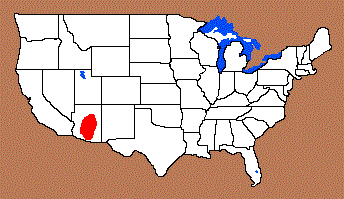Other Websites with Detailed Information:
Name Details:
Named By: Charles M. Hoffman
Named For: Sauceda Mountains, Arizona
Date Identified: 1997
Type Site:
Sauceda Side Notch
Cluster: Pueblo Side Notch Cluster
Commonly Utilized Material:
Obsidian
Date:
Cultural Period:
700 - 500 B.P.
Classic - Late Prehistory
Medieval Warm to
Little Ice Age
Hohokam Culture
Glacial Period:
Culture:
Outline is Representative of Size and Shape:
Description of Physical Characteristics and Flaking Pattern:
This is a
thin small
triangular side notch point with a flattened cross section. The blade is straight with small narrow parallel notches entering the blade towards the base on a
horizontal axis. The shoulders are horizontal with and expanded stem. The base may vary from most commonly straight to
concave and is squared and wider than the shoulders. This point has a random flaking pattern.
Size Measurement: Total Length - 20 to 34 mm, Stem Length -
6 to 8 mm, Blade Width - 9 to 14 mm, Neck Width - 4 to 7
mm, Basal Width - 9 to 14 mm, Thickness - 2 to 4 mm
Distribution:
Distribution Comments:
This point is primarily found in the Gila Bend region of south-central Arizona and into other Hohokam occupation and trading regions.

Related / Associated Points:
Additional Comments:
This point is commonly found in association with
Snaketown type points. This point has been described as an un-serrated
Snaketown Side Notch point.
Pictures:


Point Validity: Valid Type
Hoffman was a distinguished
anthropologist and a professor at the University of Arizona. He specialized in archaeology of the Southwest, Florida and the Caribbean. This type was named in his Ph.D dissertation on arrow types of the Hohokam culture and has many professional references. This is considered a valid type.
.
Age Details:
Pictures Provided By:
References: (See Reference Page, Entry Number):
30, 39
Sauceda Projectile Point, Sauceda Arrowhead
